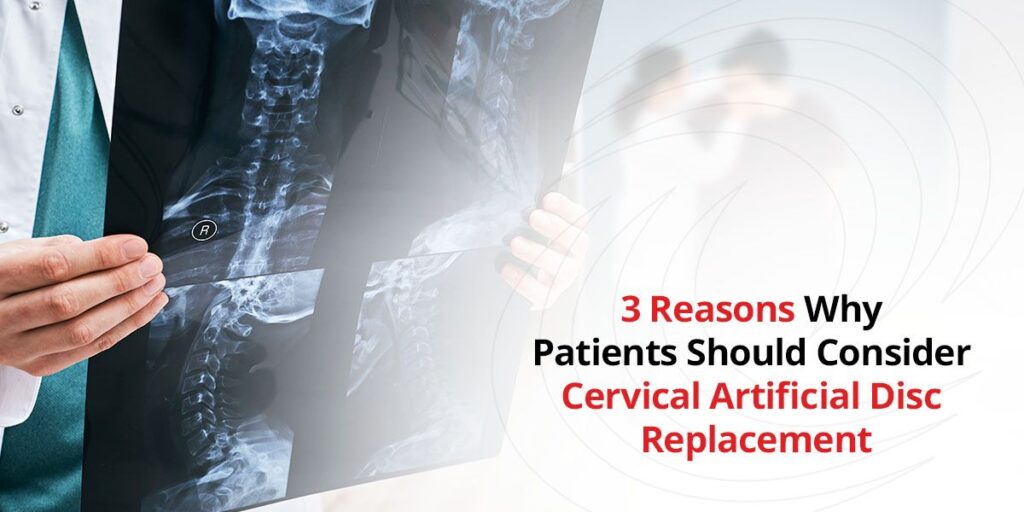
Have you been suffering from neck pain, and your spine surgeon has offered to perform a neck fusion surgery or an anterior cervical discectomy and fusion (ACDF)?
An ACDF surgery is the traditional gold standard treatment for neck symptoms related to the conditions of degenerative disc disease, a herniated disc, and a pinched nerve (radiculopathy).
Depending on your unique situation and clinical signs, an artificial disc replacement surgery (ADR) may have substantial benefits over ACDF surgery. An artificial disc can be an excellent spine fusion alternative to ACDF surgery.
An ACDF is the most common surgery spine surgeons use to treat herniated disc and degenerative disc disease in the neck. Through the front of your neck, the surgeon makes a one-inch incision and removes all the degenerative disc.
Once the disc is entirely removed, it is replaced with a bone graft or cervical PEEK cage to bridge a fusion from one vertebra to the next to maintain spinal stability. After the cage is placed, a titanium plate with screws is deployed to keep the PEEK cage in place until a fusion occurs.
Cervical total disc arthroplasty (TDR) removes all the damaged disc, like an ACDF. However, unlike an ACDF, the spine surgeon places an artificial disc implant that restores motion to the spinal segment.
Studies have shown that the cervical TDR maintains more natural biomechanics within the cervical spine and puts less stress on the discs above and below the surgical site than an ACDF.
Both surgical procedures are equivalent in relieving neck pain, arm pain, and restoring patient function, with no increase in surgical complications. However, a recent long-term study has shown three considerable advantages why patients and surgeons should choose a TDR as a spine fusion alternative surgery.
Artificial disc replacement surgery is a motion-preserving surgery that, unlike an ACDF spine fusion, maintains movement in the patient’s neck.
Because ADR surgery maintains movement, there is less stress on the patient’s neck at spinal levels above and below the ADR implant. The ACDF surgery fuses bones, creating tension on adjacent spinal levels and may lead to additional surgery.
A recent seven-year study comparing ADR versus ACDF patients found that ADR surgery significantly reduced the need for future spine surgery. Only 3% of patients with a one-level ADR at seven-year follow-up had additional surgery. Comparingly, 12.3% of ACDF patients had further surgery. In patients with two-level ADR surgery, only 4.4% needed additional surgery versus 16.2% of ACDF patients.
Artificial disc replacement offers many advantages over cervical spine fusion. The most significant benefit is preserving neck mobility where a spine fusion does not. Total disc replacement is an ideal treatment option for physically active people at work, home, or athletes. Artificial disc patients report higher satisfaction rates than those who had cervical spine fusion surgery.
Although both surgeries ACDF and ADR, effectively reduced pain and symptoms, ADR allows for a faster recovery and return to work. Both surgical patients can go back to administrative duties in a week.
ADR patients are allowed to perform strenuous work about six weeks after surgery. Whereas ACDF surgery patients must wear the brace so that the neck can fuse and heal at the surgical site prolonging their return to physical activity by up to 3 months.
Patients undergoing cervical artificial disc replacement surgery do not have to wear a neck brace. Artificial disc implants promote and preserve mobility in the neck. Patients are encouraged to start moving their necks as part of rehabilitation immediately after surgery.
Spine surgery is a significant life-changing decision. Like any necessary purchase, you do your research, compare products or services, and then make an informed decision. Why would spine surgery be any different?
If you doubt your surgeon’s diagnosis or treatment after your first spine surgeon appointment, seek a second opinion for peace of mind.
Gather All The Facts
Find The Right Surgeon
Seek an Accurate Diagnosis
Get The Right Surgical Solution
At DISC, we believe that a well-informed patient is an empowered patient. The patients that are best informed have more significant outcomes after surgery.
Patients who utilize our second opinion program have better peace of mind and are less anxious about moving forward when surgery is recommended.